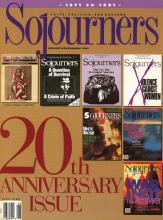Several years after we began publishing The Post-American (Sojourners' predecessor), I attended a magazine publishing conference and took a seminar on how to publish a magazine. Since none of us had ever taken a business or journalism course in our lives, it seemed like the right thing to do.
Early in the seminar the leader listed all the things that should be done to start a magazine, such as have lots of start-up capital, hire experienced business and editorial people, charge enough to establish a firm financial foundation, and thoroughly test the marketplace before finally launching the publication. Then he listed steps that should not be taken, which were essentially the opposite of the first list.
I almost laughed out loud. We had done everything wrong. We began with only $700 (pooled from seven of our next year's seminary tuitions); none of us knew anything about publishing; the subscription price on our first issue was: "$2 or whatever you can to help cover our expenses"; and we had no idea what a marketplace was, let alone how to test one.
And yet, having broken the rules, we made it through the first few years and have now managed to survive 20. It is something for which we are deeply thankful, both to God and to everyone who has at one time or another read the magazine and been part of the Sojourners family.
Of course, Sojourners was never intended as a business venture or an editorial enterprise. We had a vision about what it meant to take Jesus seriously in our lives and our world, and we wanted to communicate that vision to others. It was a thrill to know that many other Christians were thinking and feeling many of the same things, as evidenced by the subscription orders and letters of support that we began receiving almost immediately.
Read the Full Article

